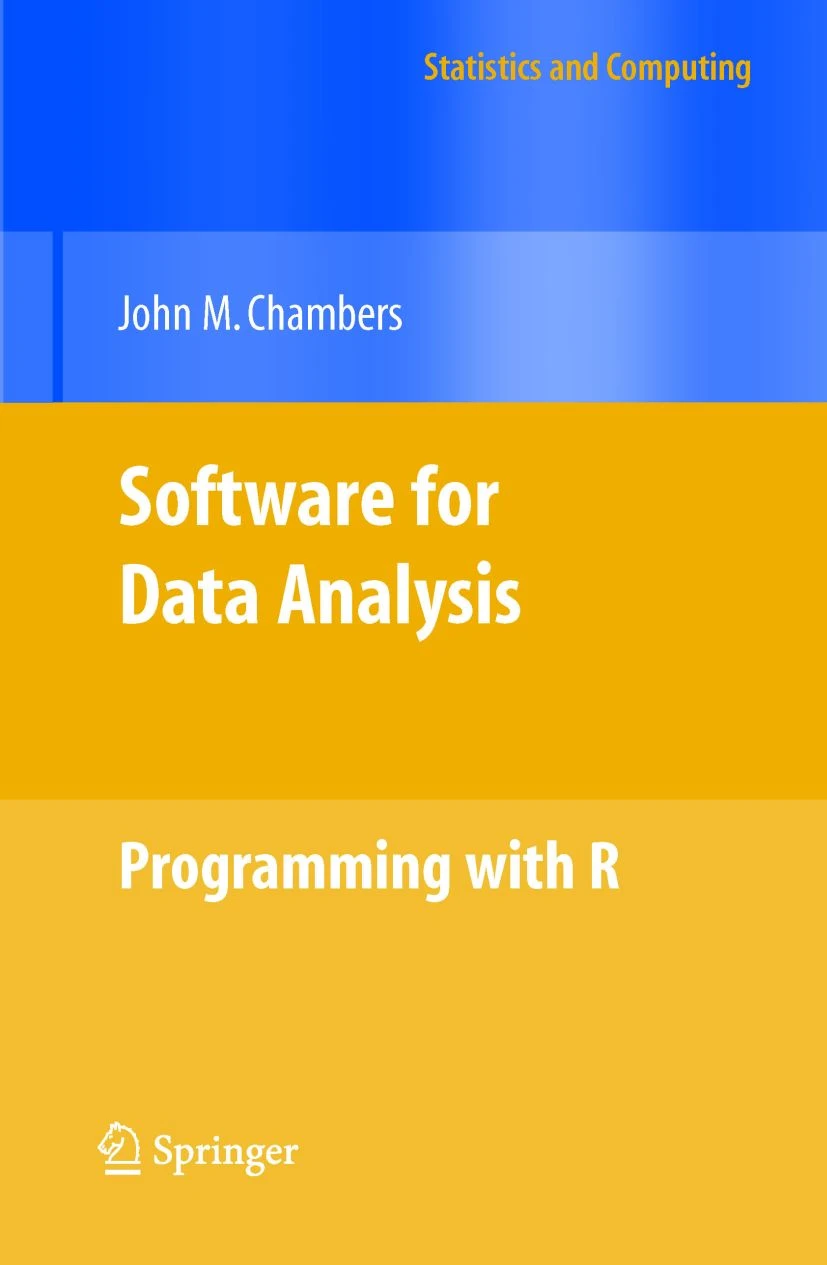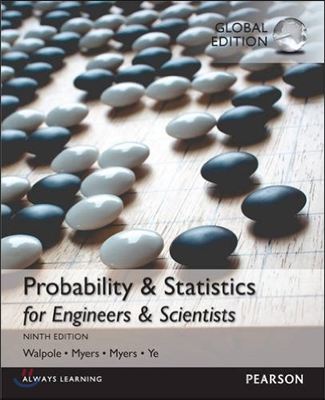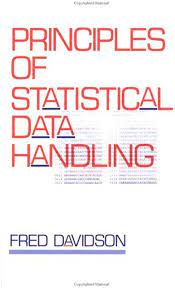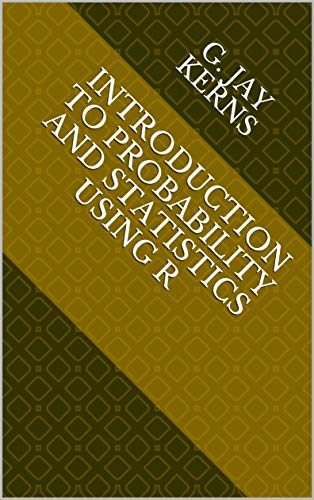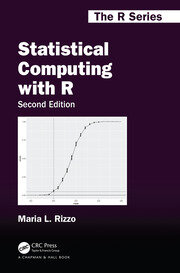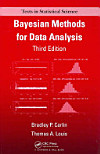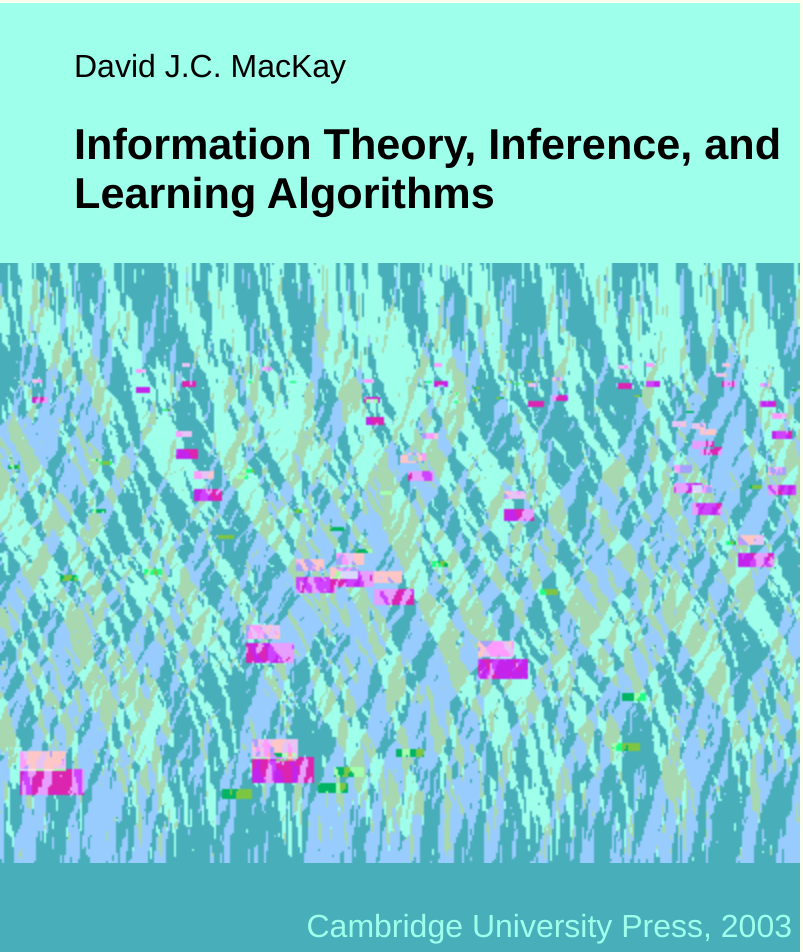In this updated post I included some R books you might want to look at if you are getting started with R for data science
Fellow data scientists, do not be overwhelmed by vast multiplicities of numbers, for they are but symbols of the natural order. Embrace their uncertainty and seek to understand the patterns within it. I offer you some of the first R books I came across. I got started with R in 2011, and I decided to update it to focus on stats and ml books I’ve come across with an attempt to list my favorites with their lecture notes and video lectures where available.
Software for data analysis: programming with R
In (Chambers 2008) the author presents the essential guidebook for those who wish to learn how to use the R programming language for data analysis. Chambers is a renowned statistician, and he shares his expertise in the field of data analysis through this book. The book covers a wide range of topics related to data analysis, including data structures, object-oriented programming, graphics, and statistical modeling. It also offers a practical approach to understanding R programming, with an emphasis on building applications that can handle large datasets. Overall, this is a valuable resource for those who want to learn about R programming for data analysis. It is a comprehensive guide that covers all the essential aspects of data analysis and provides hands-on experience with R programming. The book is written in a clear and concise manner, making it easy to follow even for beginners.
Principles of Statistical Data Handling
In (Davidson 1996) the author offers a guide to the foundations of this field, including exploratory data analysis, hypothesis testing, and model building. Through careful attention and disciplined study, one can cultivate a deep understanding of the methods and techniques that underlie statistical data handling, and by following, we shall approach data with a rational and objective mindset, illuminating with our analytical skills the meaningful insights and so make more informed decisions.
A Stoic would say “Remember, the data is not what you see, but what you make of it. So, approach it with a clear mind, free from bias and preconceptions, and seek the truth that lies hidden within.” By applying oneself to these principles with diligence and perseverance, we may yet unlock the full potential of statistical data handling, and make a valuable contribution to the world of data science.
Probability & Statistics for Engineers and Scientists
In (Walpole et al. 2007), the autor presents a path to comprehension of probability and statistics is laid out before you.
It is a journey of discovery that will require patience, diligence, and a willingness to learn. The author presents the tools and techniques needed to analyze data and draw meaningful conclusions. By using R, one can unlock the secrets hidden in the data.
Fear not mistakes, for they are but stepping stones towards deeper understanding, only take care to learn from them, and use the knowledge gained to improve your understanding daily.
With each chapter, you will gain a greater understanding of the complex and interconnected world of probability and statistics.
Embrace the journey, and may the numbers guide you towards enlightenment.
Introduction to Probability and Statistics Using R
In (Kerns 2018), recommended by my old friend Adam Hyland, the author covers the basic concepts of probability and statistics using the R programming language.
It is a useful resource for data scientists who wish to gain a deeper understanding of probability and statistics and how to apply them.
Starting with basic probability, distributions, hypothesis testing, regression analysis, it then proceeds to more advanced topics such as Bayesian statistics, machine learning, and time series analysis.
Each chapter presents clear explanations, examples, and R code to help the reader grasp the theoretical concepts and apply them in practice. By including a wide range of real-world examples and datasets, it helps the readers conect the concepts and techniques with thier application to real data.
A complimentry copy is available at this link
Statistical Computing with R
In (Rizzo 2019) the author presents is a comprehensive guide to the analysis and manipulation of data using R. Within, we are introduced to a wide variety of statistical concepts and tools that enable us to explore and understand complex datasets.
Standard statistical techniques used in data analysis, such as probability, hypothesis testing are covered. We learn about the normal distribution and its importance in statistical analysis, as well as the Poisson distribution, which is used to model counts of events.
The book introduces us to the use of statistical transformations, such as the log transformation, which is often used to make skewed data more normal. We also learn about density estimation and the use of histograms and kernel density estimates to visualize data.
The concepts of sampling and random variables are explored, as well as the calculation of sample means and standard errors. We also learn about the use of random samples from Monte Carlo simulation to approximate probabilities and calculate statistics.
The book covers the use of algorithms and samplers, such as the Metropolis-Hastings algorithm, to explore parameter space and to generate samples from distributions of interest. We learn about the importance of convergence and the use of proposals in Monte Carlo sampling.
The concepts of bias and variance are explored, as well as the calculation of confidence intervals and the use of hypothesis testing to evaluate statistical significance. We also learn about the use of the bootstrap and jackknife methods to find the level of uncertainty in our estimates.
Throughout the book, we are introduced to the use of R for statistical computing. We learn about the use of formulas to specify statistical models, as well as the use of packages for data manipulation and visualization.
Overall, “Statistical Computing with R” is an essential resource for anyone interested in using statistical methods to analyze data. It provides a lucid and comprehensive treatment of statistical concepts and their practical implementation using R.
Bayesian methods of Data Analysis
In (Carlin and Louis 2008) the author presents us with a framework that is grounded in the philosophy of probability theory. We learn to seek a baseline model then approach the problem at hand with a Bayesian perspective.
Through the use of Bayesian models, we can compute the conditional distributions of our data and evaluate the error and loss functions. We must consider convergence, the choice of priors, and how they are specified. We use Bayes’ rule to compute the posterior distribution and marginal likelihood, and we obtain point estimates and credible intervals.
The use of the Gibbs sampler and the Metropolis-Hastings algorithm in MCMC methods are presented as tools to obtain a sample from the posterior distribution. We use WinBUGS code and Monte Carlo simulations to produce results that are in line with the data observed.
We are introduced to the concept of the Bayes factor, and how it is used to compare models. We also understand how the use of the Jeffreys prior, the hyperprior, and the conjugate prior can be used to simplify our computations.
In Bayesian methods, we use the full conditional distributions to obtain the joint posterior distribution of our parameters. We also compute the marginal posterior distribution, which can be used to obtain a credible interval.
We are shown how to deal with univariate and multivariate data, and how to model the random effects and covariate effects. We also understand how to evaluate the performance of our models through histograms, percentiles, and plots.
In this work, we are presented with a practical and useful guide to Bayesian methods that can be applied to a variety of problems.
Information Theory, Inference and Learning Algorithms
Information Theory, Inference and Learning Algorithms (MacKay 2003) by David J.C. MacKay FRS - Course notes: Information Theory, Pattern Recognition, and Neural Networks.
This is not an R book as far as I recall but it is available online, together with lectures by the author. I recommend this book and videos for anyone interested bayesian data analysis. The author was a physicist, a leading bayesian and pioneer in Bayesian Neural Networks whose work is very relavant even today (2024)
References
Citation
@online{bochman2011,
author = {Bochman, Oren},
title = {R {Books}},
date = {2011-08-26},
url = {https://orenbochman.github.io/posts/2011/2011-08-26-R-books/},
langid = {en}
}
